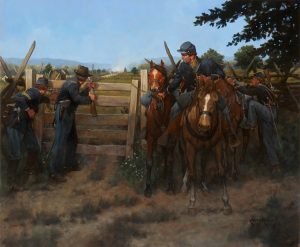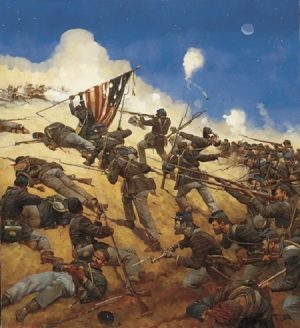50 signed and numbered prints
The wounded officer depicted in this painting, Lieutenant Colonel Henry Watson Williamson, of the 6th Virginia Infantry, was born 23 September 1823 to Thomas and Anne Williamson in Norfolk, Virginia. After graduating from the Virginia Military Institute in 1845 he served in Braxton Bragg’s battery during the Mexican War and returned to Virginia to work as a civil engineer prior to the outbreak of the war.
When Virginia seceded, Williamson enlisted as a private in the local militia, nicknamed the “Southern Guard”, which ultimately became Company G of the 6th Virginia Infantry on 19
April 1861.
In 1862, assigned to the brigade of Brigadier General William B. Mahone, the 6th Virginia elected Williamson as its Lieutenant Colonel in May. Shortly thereafter, he led the regiment through the Seven Days’ Campaign on the Peninsula, On 30 August 1862 at Second Manassas, Williamson took a wound in the right hip. His regiment fought at Antietam, Fredericksburg, Chancellorsville, and Bristoe Station.
Wounded in the right hand during the Wilderness Campaign of May 1864, Williamson remained with the regiment only to be wounded a second time, losing his left hand, at Spotsylvania. Despite these injuries, Williamson remained in the army for the battle of the Crater at Petersburg on 30 July 1864.
With the armies stalemated at Petersburg, the 48th Pennsylvania Infantry, a regiment of coal miners, boldly conceived a plan to break the deadlock. Drawing on siege warfare techniques from previous centuries, coupled with developments in mining and explosives, the Pennsylvanians tunneled their way underneath Confederate lines, where they planted 8,000 pounds of explosives. At approximately 4:45 A.M. the four tons of gunpowder detonated, ripping a hole 170 feet long, 60-80 feet wide and 30 feet deep.
The Union army had indeed achieved a horrific surprise; however, Federal Brigadier General Edward Ferrero mismanaged the follow-up attack.
Mahone’s Virginia brigade rushed forward to plug the gap. The 6th Virginia led the charge of the brigade against the Federal forces in the Crater. Met by volleys from the Union defenders and a storm of case shot from the artillery, the Virginians suffered terrible casualties in their headlong charge. “Every company left more than half its numbers among the dead or wounded.” recalled Sergeant Cross. The 6th Virginia sent a scant one hundred men into the battle – and suffered eighty killed or wounded (a loss rate comparable to that of the 1st Minnesota at Gettysburg). Here Williamson suffered his third wound in less than three months; it required amputation of the remainder of his left arm.
Lieutenant Colonel Williamson returned to civilian life in Lexington, Virginia, where he became assistant professor and later librarian at V.M.I. By 1876 he worked as a construction engineer for the Eastern Seaboard Railroad. He died in 1884 and is buried on the grounds of V.M.I.
| Medium | |
|---|---|
| Size | 16" x 12" |
| Type |



